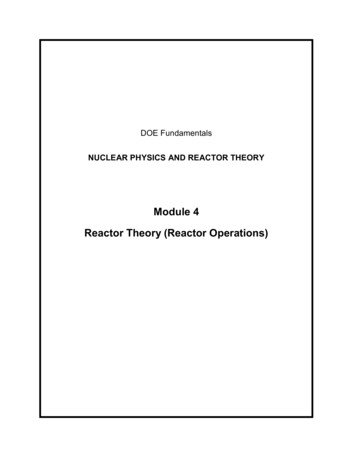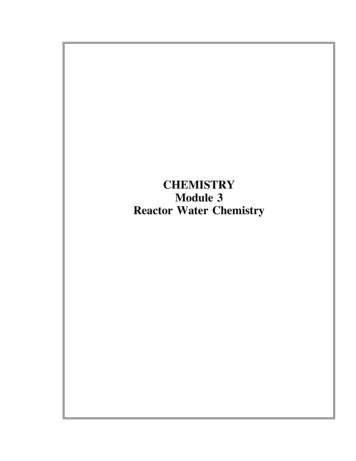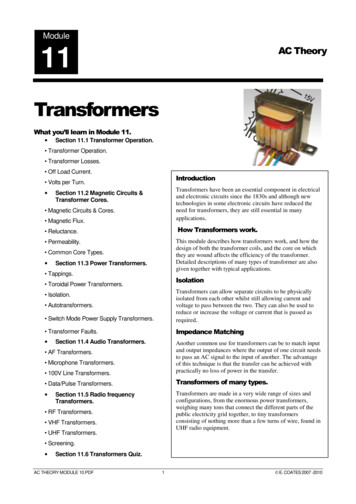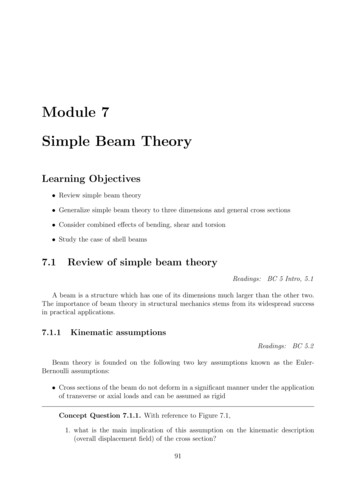
Transcription
DOE FundamentalsNUCLEAR PHYSICS AND REACTOR THEORYModule 4Reactor Theory (Reactor Operations)
Reactor Theory (Operations)TABLE OF CONTENTST able of Co nte ntsTABLE OF CONTENTS . iLIST OF FIGURES . iiiLIST OF TABLES . iiiREFERENCES .ivOBJECTIVES . vSUBCRITICAL MULTIPLICATION . 1Subcritical Multiplication Factor . 1Effect of Reactivity Changes on Subcritical Multiplication . 3Use of 1/M Plots . 6Summary . 9REACTOR KINETICS . 10Reactor Period (t) . 10Effective Delayed Neutron Fraction . 11Effective Delayed Neutron Precursor Decay Constant . 13Prompt Criticality. 15Stable Period Equation . 16Reactor Startup Rate (SUR) . 16Doubling Time. 17Summary . 20REACTOR OPERATION . 22Startup . 22Estimated Critical Position . 23Core Power Distribution . 24Power Tilt. 26Shutdown Margin . 26Operation . 27Temperature . 27Pressure . 28Power Level . 28i
Reactor Theory (Operations)Flow . 28Core Burnup . 29Shutdown . 30Decay Heat . 31Summary . 32ii
Reactor Theory (Operations)LIST OF FIGURESFigure 1 1/M Plot vs. Rod Withdrawal . 8Figure 2 Reactor Power Response to Positive Reactivity Addition . 14Figure 3 Reactor Power Response to Negative Reactivity Addition . 15Figure 4 Neutron Radial Flux Shapes for Bare and Reflected Cores . 25Figure 5 Effect of Non-Uniform Enrichment on Radial Flux Shape . 25Figure 6 Effect of Control Rod Position on Axial Flux Distribution . 26LIST OF TABLESTable 1 Delayed Neutron Fractions for Various Fuels . 12iii
Reactor Theory (Operations)REFERENCES Foster, Arthur R. and Wright, Robert L. Jr., Basic Nuclear Engineering, 4thEdition, Allyn and Bacon, Inc., 1983. Jacobs, A.M., Kline, D.E., and Remick, F.J., Basic Principles of Nuclear Scienceand Reactors, Van Nostrand Company, Inc., 1960. Kaplan, Irving, Nuclear Physics, 2nd Edition, Addison-Wesley Company, 1962. Knief, Ronald Allen, Nuclear Engineering: Theory and Practice of CommercialNuclear Power, 2nd Edition, McGraw-Hill, 1992. Lamarsh, John R., Introduction to Nuclear Engineering, 3rd Edition, AddisonWesley Company, 2001. Lamarsh, John R., Introduction to Nuclear Reactor Theory, American NuclearSociety, 2002. Knolls Atomic Power Lab, Nuclides and Isotopes: Chart of the Nuclides, 17thEdition, Knolls Atomic Power Lab, 2010. Academic Program for Nuclear Power Plant Personnel, Volume III, Columbia,MD, General Physics Corporation, Library of Congress Card #A 326517, 1982. Glasstone, Samuel, Sourcebook on Atomic Energy, 3rd Edition, Robert F.Krieger Publishing Company, Inc., 1979. Glasstone, Samuel and Sesonske, Alexander, Nuclear Reactor Engineering, 4thEdition, Van Nostrand Reinhold Company, 1994.iv
Reactor Theory (Operations)OBJECTIVESTERMINAL OBJECTIVE1.0Given the necessary information and equations, EXPLAIN how subcriticalmultiplication occurs.ENABLING OBJECTIVES1.1DEFINE the following terms:a.Subcritical multiplicationb.Subcritical multiplication factor1.2Given a neutron source strength and a subcritical system of known k eff,CALCULATE the steady-state neutron level.1.3Given an initial count rate and keff, CALCULATE the final count rate that willresult from the addition of a known amount of reactivity.1.4Given count rates vs. the parameter being adjusted, ESTIMATE the value of theparameter at which the reactor will become critical through the use of a 1/M plot.TERMINAL OBJECTIVE2.0Given the necessary information and equations, DESCRIBE how power changesin a reactor that is near criticality.ENABLING OBJECTIVES2.1DEFINE the following terms:a. Reactor periodb. Doubling timec. Reactor startup rate2.2DESCRIBE the relationship between the delayed neutron fraction, averagedelayed neutron fraction, and effective delayed neutron fraction.2.3WRITE the period equation and IDENTIFY each symbol.2.4Given the reactivity of the core and values for the effective average delayedneutron fraction and decay constant, CALCULATE the reactor period and thestartup rate.2.5Given the initial power level and either the doubling or halving time,CALCULATE the power at any later time.2.6Given the initial power level and the reactor period, CALCULATE the power atany later time.v
Reactor Theory (Operations)2.7EXPLAIN what is meant by the terms prompt drop and prompt jump.2.8DEFINE the term prompt critical.2.9DESCRIBE reactor behavior during the prompt critical condition.2.10EXPLAIN the use of measuring reactivity in units of dollars.TERMINAL OBJECTIVE3.0Without references, EXPLAIN the concepts concerning reactor startup,operation, and shutdown.ENABLING OBJECTIVES3.1EXPLAIN why a startup neutron source may be required for a reactor.3.2LIST four variables typically involved in a reactivity balance.3.3EXPLAIN how a reactivity balance may be used to predict the conditions underwhich the reactor will become critical.3.4LIST three methods used to shape or flatten the core power distribution.3.5DESCRIBE the concept of power tilt.3.6DEFINE the term shutdown margin.3.7EXPLAIN the rationale behind the one stuck rod criterion.3.8IDENTIFY five changes that will occur during and after a reactor shutdown thatwill affect the reactivity of the core.3.9EXPLAIN why decay heat is present following reactor operation.3.10LIST three variables that will affect the amount of decay heat present followingreactor shutdown.3.11ESTIMATE the approximate amount of decay heat that will exist one hour after ashutdown from steady state conditions.vi
Reactor Theory (Operations)SUBCRITICAL MULTIPLICATIONSubcritical multiplication is the phenomenon that accounts for the changesin neutron flux that takes place in a subcritical reactor due to reactivitychanges. It is important to understand subcritical multiplication in order tounderstand reactor response to changes in conditions.EO 1.1DEFINE the following terms:a.Subcritical multiplicationb.Subcritical multiplication factorEO 1.2Given a neutron source strength and a subcritical system of knownkeff, CALCULATE the steady-state neutron level.EO 1.3Given an initial count rate and keff, CALCULATE the final count ratethat will result from the addition of a known amount of reactivity.EO 1.4Given count rates vs. the parameter being adjusted, ESTIMATE thevalue of the parameter at which the reactor will become criticalthrough the use of a 1/M plot.Subcritical Multiplication FactorWhen a reactor is in a shutdown condition, neutrons are still present to interact with thefuel. These source neutrons are produced by a variety of methods that were discussedin Module 2. If neutrons and fissionable material are present in the reactor, fission willtake place. Therefore, a reactor will always be producing a small number of fissionseven when it is shutdown.Consider a reactor in which keff is 0.6. If 100 neutrons are suddenly introduced into thereactor, these 100 neutrons that start the current generation will produce 60 neutrons(100 x 0.6) from fission to start the next generation. The 60 neutrons that start thesecond generation will produce 36 neutrons (60 x 0.6) to start the third generation. Thenumber of neutrons produced by fission in subsequent generations due to theintroduction of 100 source neutrons into the reactor is shown h12thNeutrons100603622138532100Because the reactor is subcritical, neutrons introduced in the reactor will have adecreasing effect on each subsequent generation. The addition of source neutrons tothe reactor containing fissionable material has the effect of maintaining a much higherstable neutron level due to the fissions occurring than the neutron level that would result1
Reactor Theory (Operations)from the source neutrons alone. The effects of adding source neutrons at a rate of 100neutrons per generation to a reactor with a k eff of 0.6 are shown below.Generation1st2nd3rd4th5th6th7th8th9th10th tal n100 160 196 218 231 239 244 247249250250.A neutron source strength of 100 neutrons per generation will result in 250 neutrons pergeneration being produced from a combination of sources and fission in a shutdownreactor with a keff of 0.6. If the value of keff were higher, the source neutrons wouldproduce a greater number of fission neutrons and their effects would be felt for a largernumber of subsequent generations after their addition to the reactor.The effect of fissions in the fuel increasing the effective source strength of a reactor witha keff of less than one is subcritical multiplication. For a given value of keff there exists asubcritical multiplication factor (M) that relates the source level to the steady-stateneutron level of the core. If the value of keff is known, the amount that the neutronsource strength will be multiplied (M) can easily be determined by Equation (4-1).M 1/1 - keff.(4-1)2
Reactor Theory (Operations)Example:Calculate the subcritical multiplication factors for the following values of k eff.1.keff 0.62.keff 0.986Solution:1.M M 11 - keff11 – 0.62.511 - keff11 – 0.98671.4The example above illustrates that the subcritical multiplication factor will increase aspositive reactivity is added to a shutdown reactor, increasing the value of keff. If thesource strength of this reactor were 1000 neutrons/sec, the neutron level wouldincrease from 2500 neutrons/second at a k eff of 0.6 to a neutron level of 71,400neutrons/sec at a keff of 0.986.Effect of Reactivity Changes on Subcritical MultiplicationIn a subcritical reactor, the neutron level is related to the source strength by Equation(4-2).N (S) (M)(4-2)where:N neutron levelS neutron source strengthM subcritical multiplication factorIf the term M in Equation (4-2) is replaced by the expression 1/1-keff from Equation (4-1),the following expression results.3
Reactor Theory (Operations)(4-3)Example:A reactor contains a neutron source that produces 110,000 neutrons per second.The reactor has a keff of 0.986. Calculate the stable total neutron production ratein the reactor.Solution:The neutron production rate is calculated using Equation (4-3).To this point it has been necessary to know the neutron source strength of the reactor inorder to use the concept of subcritical multiplication. In most reactors the actual strengthof the neutron sources is difficult, if not impossible, to determine Even though the actualsource strength may not be known, it is still possible to relate the change in reactivity toa change in neutron level.Consider a reactor at two different times when keff is two different values, k1 and k2. Theneutron level at each time can be determined based on the neutron source strength andthe subcritical multiplication factor using Equation (4-3).The equation for N1 can be divided by the equation for N2.4
Reactor Theory (Operations)Because the source strength appears in both the numerator and denominator, it cancelsout of the equation. Therefore, the neutron level at any time can be determined basedon the neutron level present at any other time provided the values of k eff or reactivity forboth times are known.The neutron level in a shutdown reactor is typically monitored using instruments thatmeasure the neutron leakage out of the reactor. The neutron leakage is proportional tothe neutron level in the reactor. Typical units for displaying the instrument reading arecounts per second (cps). Because the instrument count rate is proportional to theneutron level, the above equation can be restated as shown in Equation (4-4).(4-4)where:CR1 count rate at time 1CR2 count rate at time 2k1 keff at time 1k2 keff at time 2Equation (4-4) is very useful during the shutdown operation of a reactor. Before addingpositive reactivity to a reactor, it is possible to predict the effect the reactivity additionwill have on the neutron level.Example:A reactor that has a reactivity of -1000 pcm has a count rate of 42 counts persecond (cps) on the neutron monitoring instrumentation. Calculate what theneutron level should be after a positive reactivity insertion of 500 pcm from thewithdrawal of control rods.Solution:Step 1:Determine the initial value of keff for the core.5
Reactor Theory (Operations)Step 2:Determine the final value of keff for the core. The final value ofreactivity will be -500 pcm (-1000 500)Step 3:Use Equation (4-4) to determine the final count rateNotice from this example that the count rate doubled as the reactivity was halved (e.g.,reactivity was changed from -1000 pcm to -500 pcm).Use of 1/M PlotsBecause the subcritical multiplication factor is related to the value of k eff, it is possible tomonitor the approach to criticality through the use of the subcritical multiplication factor.As positive reactivity is added to a subcritical reactor, k eff will get nearer to one. As keffgets nearer to one, the subcritical multiplication factor (M) gets larger. The closer thereactor is to criticality, the faster M will increase for equal step insertions of positivereactivity. When the reactor becomes critical, M will be infinitely large. For this reason,monitoring and plotting M during an approach to criticality is impractical because thereis no value of M at which the reactor clearly becomes critical.Instead of plotting M directly, its inverse (1/M) is plotted on a graph of 1/M versus rodheight.6
Reactor Theory (Operations)As control rods are withdrawn and keff approaches one and M approaches infinity, 1/Mapproaches zero. For a critical reactor, 1/M is equal to zero. A true 1/M plot requiresknowledge of the neutron source strength. Because the actual source strength isusually unknown, a reference count rate is substituted, and the calculation of the factor1/M is through the use of Equation (4-5).where:1/M inverse multiplication factorCR0 reference count rateCR current count rateIn practice, the reference count rate used is the count rate prior to the beginning of thereactivity change. The startup procedures for many reactors include instructions toinsert positive reactivity in incremental steps with delays between the reactivityinsertions to allow time for subcritical multiplication to increase the steady-state neutronpopulation to a new, higher level and allow more accurate plotting of 1/M. The neutronpopulation will typically reach its new steady-state value within 1-2 minutes, but thecloser the reactor is to criticality, the longer the time will be to stabilize the neutronpopulation.Example:Given the following rod withdrawal data, construct a 1/M plot and estimate therod position when criticality would occur. The initial count rate on the nuclearinstrumentation prior to rod withdrawal is 50 cps.Rod Withdrawal (inches)24681012Count Rate (cps)5567861201925007
Reactor Theory (Operations)Solution:Step 1:Calculate 1/M for each of the rod positions using equation (4-5).The reference count rate is 50 cps at a rod position of zero.Rod WithdrawalCount 181200.417101920.260125000.100Step 2:Plotting these values, as shown in Figure 1, and extrapolating to a1/M value of 0 reveals that the reactor will go critical atapproximately 13 inches of rod withdrawal.Figure 1: 1/M Plot vs. Rod Withdrawl8
Reactor Theory (Operations)SummaryThe important information in this chapter is summarized below.Subcritical Multiplication Summary Subcritical multiplication is the effect of fissions in the fuel increasing the effectivesource strength of a reactor with a keff less than one. Subcritical multiplication factor is the factor that relates the source level to thesteady-state neutron level of the core. The steady-state neutron level of a subcritical reactor can be calculated based onthe source strength and keff using Equation (4-3). The count rate expected in a subcritical reactor following a change in reactivitycan be calculated based on the initial count rate, initial k eff, and amount ofreactivity addition using Equation (4-4). 1/M plots can be used to predict the point of criticality.9
Reactor Theory (Operations)REACTOR KINETICSThe response of neutron flux and reactor power to changes in reactivity ismuch different in a critical reactor than in a subcritical reactor. Thereliance of the chain reaction on delayed neutrons makes the rate ofchange of reactor power controllable.EO 2.1DEFINE the following terms:a. Reactor periodb. Doubling timec. Reactor startup rateEO 2.2DESCRIBE the relationship between the delayed neutron fraction,average delayed neutron fraction, and effective delayed neutronfraction.EO 2.3WRITE the period equation and IDENTIFY each symbol.EO 2.4Given the reactivity of the core and values for the effective averagedelayed neutron fraction and decay constant, CALCULATE thereactor period and the startup rate.EO 2.5Given the initial power level and either the doubling or halving time,CALCULATE the power at any later time.EO 2.6Given the initial power level and the reactor period, CALCULATEthe power at any later time.EO 2.7EXPLAIN what is meant by the terms prompt drop and promptjump.EO 2.8DEFINE the term prompt critical.EO 2.9DESCRIBE reactor behavior during the prompt critical condition.EO 2.10EXPLAIN the use of measuring reactivity in units of dollars.Reactor Period (t)The reactor period is defined as the time required for reactor power to change by afactor of "e," where "e" is the base of the natural logarithm and is equal to about 2.718.The reactor period is usually expressed in units of seconds. From the definition ofreactor period, it is possible to develop the relationship between reactor power andreactor period that is expressed by Equation (4-6).P P0 et/ԏ(4-6)10
Reactor Theory (Operations)where:P transient reactor powerPo initial reactor powerԏ reactor period (seconds)t time during the reactor transient (seconds)The smaller the value of ԏ the more rapid the change in reactor power. If the reactorperiod is positive, reactor power is increasing. If the reactor period is negative, reactorpower is decreasing.There are numerous equations used to express reactor period, but Equation (4-7)shown below, or portions of it, will be useful in most situations. The first term in Equation(4-7) is the prompt term and the second term is the delayed term.(4-7)where:Effective Delayed Neutron FractionRecall that ẞ, the delayed neutron fraction, is the fraction of all fission neutrons that areborn as delayed neutrons. The value of ẞ depends upon the actual nuclear fuel used.As discussed in Module 1, the delayed neutron precursors for a given type of fuel aregrouped on the basis of half-life. The following table lists the fractional neutron yields foreach delayed neutron group of three common types of fuel.11
Reactor Theory (Operations)TABLE 1Delayed Neutron Fractions for Various FuelsHalf-Life (sec)Uranium-235 OTALThe term ẞ (pronounced beta-bar) is the average delayed neutron fraction. The value ofẞ is the weighted average of the total delayed neutron fractions of the individual typesof fuel. Each total delayed neutron fraction value for each type of fuel is weighted by thepercent of total neutrons that the fuel contributes through fission. If the percentage offissions occurring in the different types of fuel in a reactor changes over the life of thecore, the average delayed neutron fraction will also change. For a light water reactorusing low enriched fuel, the average delayed neutron fraction can change from 0.0070to 0.0055 as uranium-235 is burned out and plutonium-239 is produced from uranium238.Delayed neutrons do not have the same properties as prompt neutrons released directlyfrom fission. The average energy of prompt neutrons is about 2 MeV. This is muchgreater than the average energy of delayed neutrons (about 0.5 MeV). The fact thatdelayed neutrons are born at lower energies has two significant impacts on the waythey proceed through the neutron life cycle. First, delayed neutrons have a much lowerprobability of causing fast fissions than prompt neutrons because their average energyis less than the minimum required for fast fission to occur. Second, delayed neutronshave a lower probability of leaking out of the core while they are at fast energies,because they are born at lower energies and subsequently travel a shorter distance asfast neutrons. These two considerations (lower fast fission factor and higher fast nonleakage probability for delayed neutrons) are taken into account by a term called theimportance factor (I). The importance factor relates the average delayed neutronfraction to the effective delayed neutron fraction.The effective delayed neutron fraction (ẞeff) is defined as the fraction of neutrons atthermal energies which were born delayed. The effective delayed neutron fraction is theproduct of the average delayed neutron fraction and the importance factor.ẞeff ẞI12
Reactor Theory (Operations)where:ẞeff effective delayed neutron fractionẞ average delayed neutron fractionI importance factorIn a small reactor with highly enriched fuel, the increase in fast non-leakage probabilitywill dominate the decrease in the fast fission factor, and the importance factor will begreater than one. In a large reactor with low enriched fuel, the decrease in the fastfission factor will dominate the increase in the fast non-leakage probability and theimportance factor will be less than one (about 0.97 for a commercial PWR).Effective Delayed Neutron Precursor Decay ConstantAnother new term has been introduced in the reactor period (ԏ) equation. That term isλeff (pronounced lambda effective), the effective delayed neutron precursor decayconstant. The decay rate for a given delayed neutron precursor can be expressed asthe product of precursor concentration and the decay constant (λ) of that precursor. Thedecay constant of a precursor is simply the fraction of an initial number of the precursoratoms that decays in a given unit time. A decay constant of 0.1 sec -1, for example,implies that one-tenth, or ten percent, of a sample of precursor atoms decays within onesecond. The value for the effective delayed neutron precursor decay constant, λeff,varies depending upon the balance existing between the concentrations of theprecursor groups and the nuclide(s) being used as the fuel.If the reactor is operating at a constant power, all the precursor groups reach anequilibrium value. During an up-power transient, however, the shorter-lived precursorsdecaying at any given instant were born at a higher power level (or flux level) than thelonger-lived precursors decaying at the same instant. There is, therefore,proportionately more of the shorter-lived and fewer of the longer-lived precursorsdecaying at that given instant than there are at constant power. The value of 1 eff iscloser to that of the shorter-lived precursors.During a down-power transient the longer-lived precursors become more significant.The longer-lived precursors decaying at a given instant were born at a higher powerlevel (or flux level) than the shorter-lived precursors decaying at that instant. Therefore,proportionately more of the longer-lived precursors are decaying at that instant, and thevalue of λeff approaches the values of the longer-lived precursors.Approximate values for λeff are 0.08 sec-1 for steady-state operation, 0.1 sec-1 for apower increase, and 0.05 sec-1 for a power decrease. The exact values will dependupon the materials used for fuel and the value of the reactivity of the reactor core.13
Reactor Theory (Operations)Returning now to Equation (4-7) for reactor period.If the positive reactivity added is less than the value of ẞeff, the emission of promptfission neutrons alone is not sufficient to overcome losses to non-fission absorption andleakage. If delayed neutrons were not being produced, the neutron population woulddecrease as long as the reactivity of the core has a value less than the effective delayedneutron fraction. The positive reactivity insertion is followed immediately by a smallimmediate power increase called the prompt jump. This power increase occurs becausethe rate of production of prompt neutrons changes abruptly as the reactivity is added.Recall from an earlier module that the generation time for prompt neutrons is on theorder of 10-13 seconds. The effect can be seen in Figure 2. After the prompt jump, therate of change of power cannot increase any more rapidly than the built-in time delaythe precursor half-lives allow. Therefore, the power rise is controllable, and the reactorcan be operated safely.Figure 2 Reactor Power Response to Positive Reactivity Addition14
Reactor Theory (Operations)Conversely, in the case where negative reactivity is added to the core there will be aprompt drop in reactor power. The prompt drop is the small immediate decrease inreactor power caused by the negative reactivity addition. The prompt drop is illustratedin Figure 3. After the prompt drop, the rate of change of power slows and approachesthe rate determined by the delayed term of Equation (4-7).Figure 3 Reactor Power Response to Negative Reactivity AdditionPrompt CriticalityIt can be readily seen from Equation (4-7) that if the amount of positive reactivity addedequals the value of ẞeff, the reactor period equation becomes the following.ԏ l* / ρIn this case, the production of prompt neutrons alone is enough to balance neutronlosses and increase the neutron population. The condition where the reactor is criticalon prompt neutrons, and the neutron population increases as rapidly as the promptneutron generation lifetime allows is known as prompt critical. The prompt criticalcondition does not signal a dramatic change in neutron behavior. The reactor periodchanges in a regular manner between reactivities above and below this reference.Prompt critical is, however, a convenient condition for marking the transition from15
Reactor Theory (Operations)delayed neutron to prompt neutron time scales. A reactor whose reactivity evenapproaches prompt critical is likely to suffer damage due to the rapid rise in power to avery high level. For example, a reactor which has gone prompt critical could experiencea several th
The effects of adding source neutrons at a rate of 100 neutrons per generation to a reactor with a k eff of 0.6 are shown below. Generation 1st 2nd 3rd 4th 5th 6th 7th 8th 9th 10th 11th 12th 100 60 36 22 13 8 5 3 2 1 0 0 100 60 36 22 13 8 5 3 2 1 0 100 60 36











